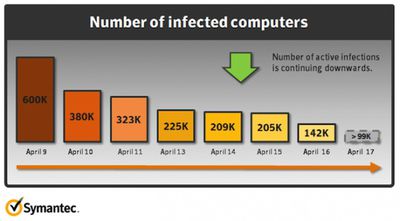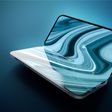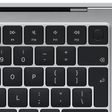Flashback Malware Still Affecting over 100,000 Macs
While Apple has pushed out several software updates to detect the Flashback malware and remove it from infected systems, Symantec noted late yesterday that over 100,000 machines remain afflicted by the issue as detected by their sinkhole operation to redirect server traffic.

Symantec pegged the number at approximately 142,000 as of Monday, listing a rough estimate of "over 99,000" as yesterday's data was still coming in. Those numbers are down from a peak of over 600,000 machines two weeks ago, but a substantial number of machines are still infected by the malware.
The statistics from our sinkhole are showing declining numbers on a daily basis. However, we had originally believed that we would have seen a greater decline in infections at this point in time, but this has proven not to be the case. Currently, it appears that the number of infected computers has tapered off, but remains around the 140,000 mark.
As there have been tools released by Symantec and other vendors in the past few days concerning this threat, the infection numbers should have seen a dramatic decrease by now.
Symantec also takes a look at the domain name generator that allows infected machines to connect to their command-and-control servers to receive instructions. The generator uses a list of 14-character strings rotated each day, coupling each string with one of five top-level domains (.com, .net, .info, .in, or .kz) to find its instructions.
The report also claims that Flashback-infected systems can receive updated command-and-control server locations through Twitter, although no details on that process are provided. A similar claim was made for earlier versions of Flashback, although there has apparently been no demonstration of the Twitter delivery method actually being used.
Popular Stories
Since the iPhone X in 2017, all of Apple's highest-end iPhone models have featured either stainless steel or titanium frames, but it has now been rumored that this design decision will be coming to an end with the iPhone 17 Pro models later this year.
In a post on Chinese social media platform Weibo today, the account Instant Digital said that the iPhone 17 Pro models will have an aluminum...
Apple is continuing to refine and update iOS 26, and beta three features smaller changes than we saw in beta 2, plus further tweaks to the Liquid Glass design. Apple is gearing up for the next phase of beta testing, and the company has promised that a public beta is set to come out in July.
Transparency
In some apps like Apple Music, Podcasts, and the App Store, Apple has toned down the...
The calendar has turned to July, meaning that 2025 is now more than half over. And while the summer months are often quiet for Apple, the company still has more than a dozen products coming later this year, according to rumors.
Below, we have outlined at least 15 new Apple products that are expected to launch later this year, along with key rumored features for each.
iPhone 17 Series
iPho...
Apple should unveil the iPhone 17 series in September, and there might be one bigger difference between the Pro and Pro Max models this year.
As always, the Pro Max model will be larger than the Pro model:iPhone 17 Pro: 6.3-inch display
iPhone 17 Pro Max: 6.9-inch displayGiven the Pro Max is physically larger than the Pro, it has more internal space, allowing for a larger battery and...
In 2020, Apple added a digital car key feature to its Wallet app, allowing users to lock, unlock, and start a compatible vehicle with an iPhone or Apple Watch. The feature is currently offered by select automakers, including Audi, BMW, Hyundai, Kia, Genesis, Mercedes-Benz, Volvo, and a handful of others, and it is set to expand further.
Apple has a web page with a list of vehicle models that ...
New renders today provide the best look yet relocated Apple logo and redesigned MagSafe magnet array of the iPhone 17 Pro and iPhone 17 Pro Max.
Image via Majin Bu.
Several of the design changes coming to the iPhone 17 Pro model have been rumored for some time, such as the elongated camera bump that spans the full width of the device, with the LiDAR Scanner and flash moving to the right side.
...
Apple's next-generation iPhone 17 Pro and iPhone 17 Pro Max are just over two months away, and there are plenty of rumors about the devices.
Below, we recap key changes rumored for the iPhone 17 Pro models.
Latest Rumors
These rumors surfaced in June and July:Apple logo repositioned: Apple's logo may have a lower position on the back of the iPhone 17 Pro models, compared to previous...
Apple is expanding the ability to add an Apple Account Card to the Wallet app to more countries, according to backend Apple Pay changes.
With iOS 15.5, Apple updated the Wallet app to allow users to add an Apple Account Card, which displays the Apple credit balance associated with an Apple ID.
If you receive an Apple gift card, for example, it is added to an Apple Account that is also...





















